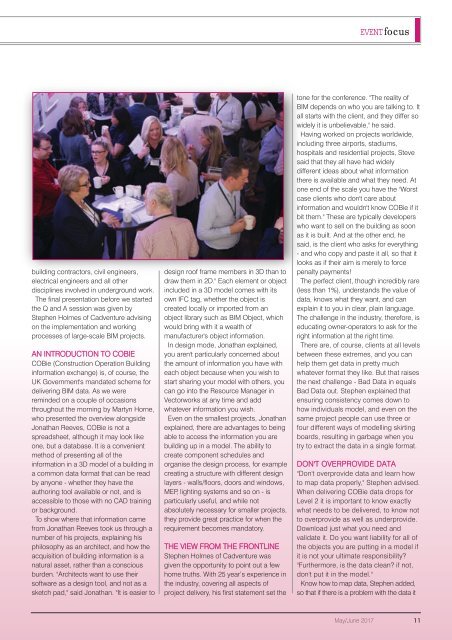You also want an ePaper? Increase the reach of your titles
YUMPU automatically turns print PDFs into web optimized ePapers that Google loves.
EVENTfocus<br />
building contractors, civil engineers,<br />
electrical engineers and all other<br />
disciplines involved in underground work.<br />
The final presentation before we started<br />
the Q and A session was given by<br />
Stephen Holmes of Cadventure advising<br />
on the implementation and working<br />
processes of large-scale BIM projects.<br />
AN INTRODUCTION TO COBIE<br />
COBie (Construction Operation Building<br />
information exchange) is, of course, the<br />
UK Government's mandated scheme for<br />
delivering BIM data. As we were<br />
reminded on a couple of occasions<br />
throughout the morning by Martyn Horne,<br />
who presented the overview alongside<br />
Jonathan Reeves, COBie is not a<br />
spreadsheet, although it may look like<br />
one, but a database. It is a convenient<br />
method of presenting all of the<br />
information in a 3D model of a building in<br />
a common data format that can be read<br />
by anyone - whether they have the<br />
authoring tool available or not, and is<br />
accessible to those with no CAD training<br />
or background.<br />
To show where that information came<br />
from Jonathan Reeves took us through a<br />
number of his projects, explaining his<br />
philosophy as an architect, and how the<br />
acquisition of building information is a<br />
natural asset, rather than a conscious<br />
burden. "Architects want to use their<br />
software as a design tool, and not as a<br />
sketch pad," said Jonathan. "It is easier to<br />
design roof frame members in 3D than to<br />
draw them in 2D." Each element or object<br />
included in a 3D model comes with its<br />
own IFC tag, whether the object is<br />
created locally or imported from an<br />
object library such as BIM Object, which<br />
would bring with it a wealth of<br />
manufacturer's object information.<br />
In design mode, Jonathan explained,<br />
you aren't particularly concerned about<br />
the amount of information you have with<br />
each object because when you wish to<br />
start sharing your model with others, you<br />
can go into the Resource Manager in<br />
Vectorworks at any time and add<br />
whatever information you wish.<br />
Even on the smallest projects, Jonathan<br />
explained, there are advantages to being<br />
able to access the information you are<br />
building up in a model. The ability to<br />
create component schedules and<br />
organise the design process, for example<br />
creating a structure with different design<br />
layers - walls/floors, doors and windows,<br />
MEP, lighting systems and so on - is<br />
particularly useful, and while not<br />
absolutely necessary for smaller projects,<br />
they provide great practice for when the<br />
requirement becomes mandatory.<br />
THE VIEW FROM THE FRONTLINE<br />
Stephen Holmes of Cadventure was<br />
given the opportunity to point out a few<br />
home truths. With 25 year’s experience in<br />
the industry, covering all aspects of<br />
project delivery, his first statement set the<br />
tone for the conference. "The reality of<br />
BIM depends on who you are talking to. It<br />
all starts with the client, and they differ so<br />
widely it is unbelievable," he said.<br />
Having worked on projects worldwide,<br />
including three airports, stadiums,<br />
hospitals and residential projects, Steve<br />
said that they all have had widely<br />
different ideas about what information<br />
there is available and what they need. At<br />
one end of the scale you have the "Worst<br />
case clients who don't care about<br />
information and wouldn't know COBie if it<br />
bit them." These are typically developers<br />
who want to sell on the building as soon<br />
as it is built. And at the other end, he<br />
said, is the client who asks for everything<br />
- and who copy and paste it all, so that it<br />
looks as if their aim is merely to force<br />
penalty payments!<br />
The perfect client, though incredibly rare<br />
(less than 1%), understands the value of<br />
data, knows what they want, and can<br />
explain it to you in clear, plain language.<br />
The challenge in the industry, therefore, is<br />
educating owner-operators to ask for the<br />
right information at the right time.<br />
There are, of course, clients at all levels<br />
between these extremes, and you can<br />
help them get data in pretty much<br />
whatever format they like. But that raises<br />
the next challenge - Bad Data in equals<br />
Bad Data out. Stephen explained that<br />
ensuring consistency comes down to<br />
how individuals model, and even on the<br />
same project people can use three or<br />
four different ways of modelling skirting<br />
boards, resulting in garbage when you<br />
try to extract the data in a single format.<br />
DON'T OVERPROVIDE DATA<br />
"Don't overprovide data and learn how<br />
to map data properly," Stephen advised.<br />
When delivering COBie data drops for<br />
Level 2 it is important to know exactly<br />
what needs to be delivered, to know not<br />
to overprovide as well as underprovide.<br />
Download just what you need and<br />
validate it. Do you want liability for all of<br />
the objects you are putting in a model if<br />
it is not your ultimate responsibility?<br />
"Furthermore, is the data clean? if not,<br />
don't put it in the model."<br />
Know how to map data, Stephen added,<br />
so that if there is a problem with the data it<br />
May/June 2017 11

















